Related Research Articles
"4th Time Around" is a song by American singer-songwriter Bob Dylan, which was released as the 12th track on his seventh studio album Blonde on Blonde on June 20, 1966. The song was written by Dylan and produced by Bob Johnston. Commentators often interpret it as a parody of the Beatles' 1965 song "Norwegian Wood ". John Lennon composed "Norwegian Wood" after being influenced by the introspective lyrics of Dylan. Lennon later reflected on his feelings of paranoia when Dylan first played him "4th Time Around".
"Absolutely Sweet Marie" is a song by American singer-songwriter Bob Dylan, which was released on the third side of the double album and Dylan's seventh studio album, Blonde on Blonde (1966). The song was written by Dylan and produced by Bob Johnston. It was recorded at around 1:00 am on March 8, 1966, at Columbia Studio A, Nashville. Some commentators have interpreted the song as being about sexual frustration.
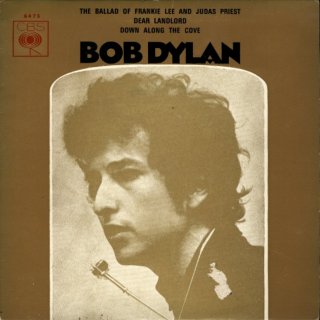
"The Ballad of Frankie Lee and Judas Priest" is a song by American singer-songwriter Bob Dylan. It was released as the fifth track on his eighth studio album John Wesley Harding (1967). The track was written by Dylan and produced by Bob Johnston. It was recorded in one take on October 17, 1967, at Columbia Studio A in Nashville. The song's lyrics refer to two friends, Frankie Lee and Judas Priest. Lee asks Priest for a loan of money and Priest offers it freely. Lee spends it in a brothel over 16 days, then dies of thirst in Priest's arms. It has been suggested by commentators that the song refers to Dylan's relationship with his manager Albert Grossman or to his contractual negotiations with his record company. The song received a mixed critical reception. Dylan performed the song live in concert 20 times, from 1987 to 2000.
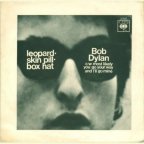
"Leopard-Skin Pill-Box Hat" is a song by the American singer-songwriter Bob Dylan, which was released on the second side of his seventh studio album Blonde on Blonde (1966). The song was written by Dylan, and produced by Bob Johnston. Dylan has denied that the song references any specific individual, although critics have speculated that it refers to Edie Sedgwick, whom Dylan had spent time with in December 1965.
"Tombstone Blues" is a song by American singer-songwriter Bob Dylan, which was released as the second track on his sixth studio album Highway 61 Revisited (1965). The song was written by Dylan, and produced by Bob Johnston. Critical interpretations of the song have suggested that the song references the Vietnam War and US President Lyndon Baines Johnson.

"Stuck Inside of Mobile with the Memphis Blues Again" is a song by American singer-songwriter Bob Dylan from his seventh studio album, Blonde on Blonde (1966). The song was written by Dylan and produced by Bob Johnston. It has nine verses, each featuring a distinct set of characters and circumstances. All 20 takes of "Stuck Inside of Mobile with the Memphis Blues Again" were recorded in the early hours of February 17, 1966, at Columbia Records's A Studio in Nashville, Tennessee, with the last take selected for the album. This version also appears on Dylan's second compilation album, Bob Dylan's Greatest Hits Vol. II (1971).
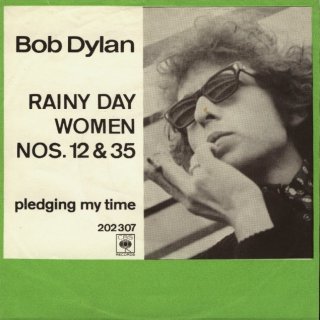
"Pledging My Time" is a blues song by the American singer-songwriter Bob Dylan from his seventh studio album, Blonde on Blonde (1966). The song, written by Dylan and produced by Bob Johnston, was recorded on March 8, 1966 in Nashville, Tennessee. Dylan is featured on lead vocals, harmonica, and guitar, backed by guitarist Robbie Robertson and an ensemble of veteran Nashville session men.
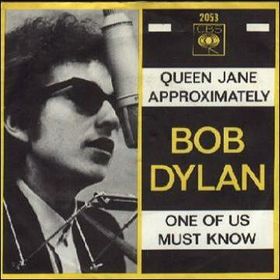
"One of Us Must Know (Sooner or Later)" is a song by the American singer-songwriter Bob Dylan, which was released as a single on February 14, 1966, and as the fourth track on his seventh studio album Blonde on Blonde in June of that year. The song was written by Dylan and produced by Bob Johnston. It is the narrator's account of a burned-out relationship. It was recorded at Columbia studio A in New York on January 25, 1966, with Dylan and other musicians developing the song through over twenty takes during the session.
"To Ramona" is a song by American singer-songwriter Bob Dylan, first released on his fourth studio album, Another Side of Bob Dylan (1964). The song was written by Dylan, and produced by Tom Wilson. The lyrics were started at the May Fair Hotel in London in May 1964, and finished during a week-long stay in the Greek village of Vernilya later that month. Dylan recorded all the tracks for the album, including the song, in a single three-hour session on June 9, 1964, at Studio A, Columbia Recording Studios, New York. Its narrator advises Ramona, who is preparing to return to "the South", not to follow the advice of others. Critics have suggested several different people as inspirations for the song, including Joan Baez, Suze Rotolo, and Sara Lownds.
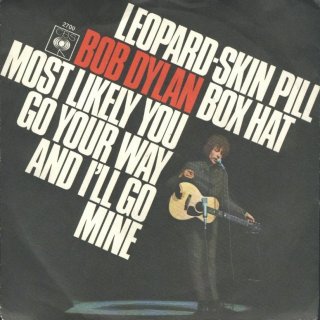
"Most Likely You Go Your Way and I'll Go Mine", or "Most Likely You Go Your Way (and I'll Go Mine)", is a song by the American singer-songwriter Bob Dylan. It was released as the first track on side three of his seventh studio album Blonde on Blonde (1966). The song was written by Dylan and produced by Bob Johnston. Dylan recounted that he had probably written the song after the end of a relationship. The song's narrator criticizes the lies and weakness of a woman, and says that he finds it hard to care. The final verse establishes that the woman has been unfaithful to the narrator by having a relationship with another man, as he suspected all along.
"John Brown" is a song by American singer-songwriter Bob Dylan. The song, written in October 1962 was released under his pseudonym "Blind Boy Grunt" on the Folkways Records compilation album Broadside Ballads, Vol. 1 (1963). Live performances have been officially released on MTV Unplugged (1995), Live at The Gaslight 1962 (2005), and Live 1962–1966 – Rare Performances From The Copyright Collections (2018). A demo version was issued on The Bootleg Series Vol. 9 – The Witmark Demos: 1962–1964 (2010).
"Where Are You Tonight? " is a song by American singer-songwriter Bob Dylan, which was released as the closing track on his 18th studio album Street-Legal (1978). The song was written by Dylan, and produced by Don DeVito. Dylan has said that the song is about the individual's "enemy within." Critical interpretations of the song have suggested that it references Dylan's divorce as well as foreshadowing or announcing his conversion to Christianity, which became evident in the religiously-focused projects that followed the album. Commentators have also opined that there are allusions in the lyrics to the work of Robert Johnson.

"Obviously 5 Believers" is a song by the American singer-songwriter Bob Dylan, which was released as the last track of side three of his double album Blonde on Blonde (1966), and was the B-side to the single release of "Just Like a Woman" for releases in America and some other countries. The song was written by Dylan and produced by Bob Johnston. It was recorded at Columbia Music Row Studios, in the early morning hours of a March 9–10, 1966 session. Four takes were recorded, although the first two were incomplete. It has been interpreted as a blues song about loneliness, with critics noting similarities in melody and structure to Memphis Minnie's "Chauffeur Blues". Dylan's vocals and the musicianship of the band on the track have both received critical acclaim, although the track has been regarded as insubstantial by some commentators.
"Temporary Like Achilles" is a song by American singer-songwriter Bob Dylan that was released on side three of his double album, Blonde on Blonde (1966). The song was written by Dylan, and produced by Bob Johnston. It was recorded at Columbia Studio A, Nashville, Tennessee on March 9, 1966. The song is a blues number that incorporates elements of Dylan's incomplete "Medicine Sunday", which he had recorded with members of the Band in New York in October 1965. The song describes a narrator's frustration at being kept waiting by a woman that he wishes to be romantically involved with, who is guarded by "Achilles". Some critics have suggested that the song references the Iliad.
"I Shall Be Free" is a song by American singer-songwriter Bob Dylan. It was recorded on 6 December 1962 at Studio A, Columbia Recording Studios, New York, produced by John Hammond. The song was released as the closing track on The Freewheelin' Bob Dylan on 27 May 1963, and has been viewed as a comedic counterpoint to the album's more serious material. Dylan has never performed the song in concert.
"Down the Highway" is a song by American singer-songwriter Bob Dylan. It was recorded on July 9, 1962 at Studio A, Columbia Recording Studios, New York, produced by John Hammond. The song was released on The Freewheelin' Bob Dylan on May 27, 1963. It is a twelve-bar blues love song, which Dylan told his girlfriend Suze Rotolo he had written about her.

"One More Cup of Coffee (Valley Below)" is a song by American singer-songwriter Bob Dylan, which was released as the fourth track on his seventeenth studio album Desire (1976). The song was written by Dylan, and produced by Don DeVito. The album version of "One More Cup of Coffee (Valley Below)" was recorded on July 30, 1975, and released on Desire in January 1976. Dylan said the song was influenced by his visit to a Romani celebration at Saintes-Maries-de-la-Mer in France on his 34th birthday.
"You're No Good" is a song by Jesse Fuller that appeared as the opening track on Bob Dylan's eponymous debut album (1962). Eight takes were recorded by Dylan on November 20, 1961. He learnt the song directly from Fuller in Denver; Fuller's own recorded version was not released until May 13, 1963, on his album San Francisco Bay Blues. The song concerns the narrator's difficult relationship with a woman, and concludes with the narrator wanting to "lay down and die". Dylan's version is more uptempo than Fuller's, and has some changes to the lyrics; it has been positively reviewed by critics.
"I Shall Be Free No. 10" is a song by American singer-songwriter Bob Dylan, which was released as the fifth track on his fourth studio album Another Side of Bob Dylan (1964). The song was written by Dylan and produced by Tom Wilson. The song is a humorous talking blues, indebted to earlier songs including Lead Belly's "We Shall Be Free". Dylan opens the song by proclaiming that he is normal and average, but then acknowledges his reputation by singing the self-aware doggerel "Yippee! I'm a poet, and I know it/ Hope I don't blow it".
"Suze (The Cough Song)" is a song by American singer-songwriter Bob Dylan, recorded in 1963 during the sessions for his third studio album, The Times They Are a-Changin' (1964). The song was written and performed by Dylan, and produced by Tom Wilson. It was released on The Bootleg Series Volumes 1–3 (Rare & Unreleased) 1961–1991 (1991).
References
Citations
- 1 2 3 4 5 Gray 2008, p. 368.
- ↑ Dahl, Bill. Curtis Jones: Trouble Blues – Review at AllMusic . Retrieved July 23, 2022.
- ↑ Dahl, Bill. Curtis Jones: Lonesome Bedroom Blues – Review at AllMusic . Retrieved July 23, 2022.
- 1 2 3 Margotin & Guesdon 2022, p. 28.
- 1 2 Shelton 1987, p. 122.
- 1 2 3 4 5 Barker 2008, p. 139.
- ↑ Bjorner, Olof. "Still on the road: 1961 concerts and recording sessions". Archived from the original on April 4, 2022. Retrieved July 22, 2022.
- 1 2 Trager 2004, p. 250-251.
- ↑ Gray 2008, p. 254.
- ↑ Rings 2013, p. 7.
- ↑ Trager 2004, p. 250.
- ↑ "Highway 51". Bob Dylan's official website. Archived from the original on January 25, 2022. Retrieved July 22, 2022.
- ↑ Shelton 1987, p. 118.
- ↑ Williams 2004, p. 35.
- 1 2 Nogowski 2008, p. 12.
- ↑ Dylan 2014, p. 2.
- ↑ Gray 2008, p. 69.
- ↑ Spencer, Neil (2015). "Bob Dylan". Uncut – Ultimate Music Guide: Bob Dylan. pp. 6–7.
Sources
- Barker, Derek (2008). The songs he didn't write : Bob Dylan under the influence. New Malden: Chrome Dreams. ISBN 978-1-84240-424-9.
- Dylan, Bob (2014). Ricks, Christopher; Nemrow, Lisa; Nemrow, Julie (eds.). The Lyrics / Bob Dylan. London: Simon & Schuster. ISBN 978-1-4711-3709-9.
- Gray, Michael (2008). The Bob Dylan Encyclopedia. London: Continuum International Publishing Group. ISBN 978-0-8264-2974-2.
- Margotin, Philippe; Guesdon, Jean-Michel (2022). Bob Dylan All the Songs: The Story Behind Every Track (Expanded ed.). New York: Black Dog & Leventhal. ISBN 978-0-7624-7573-5.
- Nogowski, John (2008). Bob Dylan: A Descriptive, Critical Discography and Filmography, 1961-2007. London: McFarland. ISBN 978-0-7864-3518-0.
- Rings, Steven (2013). "A Foreign Sound to Your Ear: Bob Dylan Performs "It's Alright, Ma (I'm Only Bleeding)", 1964–2009". Music Theory Online. 19 (4): 1–39. doi: 10.30535/mto.19.4.3 .
- Shelton, Robert (1987). No direction home: the life and music of Bob Dylan. London: Hodder & Stoughton. ISBN 978-0-450-04843-2.
- Trager, Oliver (2004). Keys to the rain: the definitive Bob Dylan encyclopedia. New York: Billboard Books. ISBN 978-0-8230-7974-2.
- Williams, Paul (2004) [1990]. Bob Dylan, performing artist: the early years, 1960–1973. London: Omnibus Press. ISBN 978-1-84449-095-0.